Bottlenose Dolphins
Bottlenose dolphin offshore form. NOAA/BW photo (21 June 2011)
Tursiops truncatus
Bottlenose dolphins are around 3’ long at birth. Adult length ranges from 7’-10’ long, males slightly larger than females. Coloration is light gray to black, fading to white, sometimes pink, on the belly, with lighter intrusions extending into darker areas. Most adults show evidence of tooth rake scarring from other dolphins. Old age for a male is in his 40s. Old age for a female is in her 50s.
Bottlenose dolphins (Tursiops truncatus) are the most common marine mammal in the coastal and estuarine waters near Cape Lookout and Beaufort, NC. They are seen here year-round. We see the highest numbers in the fall and winter, the lowest numbers in the summer. The young are raised in nursery groups that seem to generally exclude adult males. Male bottlenose dolphins have been documented to pair up near adolescence and stay together for most or all their lives. The male pair bonds form the longest consistent associations in wild bottlenose dolphin communities.
Dolphins produce and receive a variety of sounds to communicate, perceive their environment, find and capture food, and avoid threats. In general, it is thought that their sounds are produced in nasal passages between the melon and the blowhole, modulated (focused and amplified) through the melon, and received in the vicinity of the lower jaws.
North Carolinians have related to dolphins in a variety of ways ranging from commercial dolphin net fisheries (late 1700s-1920s, used primarily for oil, leather, and fertilizer) to conservation of this depleted and federally protected (Under the Marine Mammal Protection Act) population. Today, threats to bottlenose dolphins include unintentional entanglement in commercial and recreational fishing gear, ingestion of litter, contamination of food sources, boat strikes, and intentional (but illegal) feeding of dolphin by boaters. Potential impacts from noise pollution are also being investigated.



